.

How to Make Cannabis-Infused Olive Oil
In this article, explore the pros and cons of different fats for cannabis infusions, and discover how to make your own cannabis-infused olive oil at home. Not only is it a great addition to lots of dishes, but it can also be enjoyed on its own.
Cannabis-infused olive oil can be used in all sorts of recipes—even baked goods. Or, you can just drop the oil straight into your mouth to harness its properties. It’s up to you! In this article, we'll tell you everything you need to know about infusing fats with weed, introduce you to a cannabis olive oil recipe to try at home, and teach you how to dose it once it’s ready to use.
Contents:
What Is the Best Oil for Infusing Cannabis?
Each oil brings its own set of qualities to the table, from the versatile coconut oil to the gourmet walnut oil. The best choice depends on individual preferences for flavour, texture, and the desired potency. Check out some of the most favoured options below.
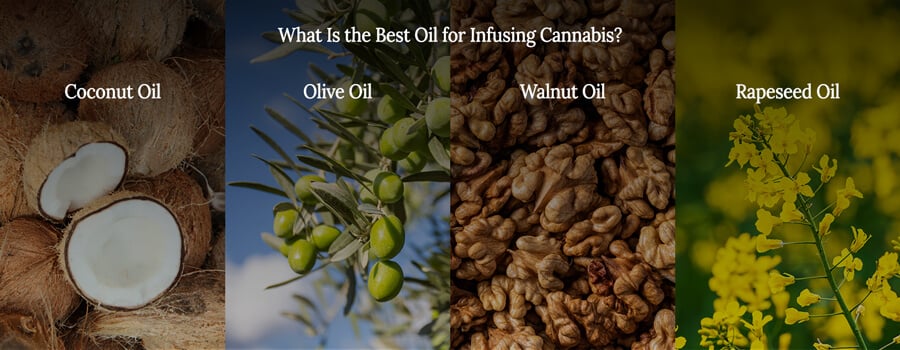
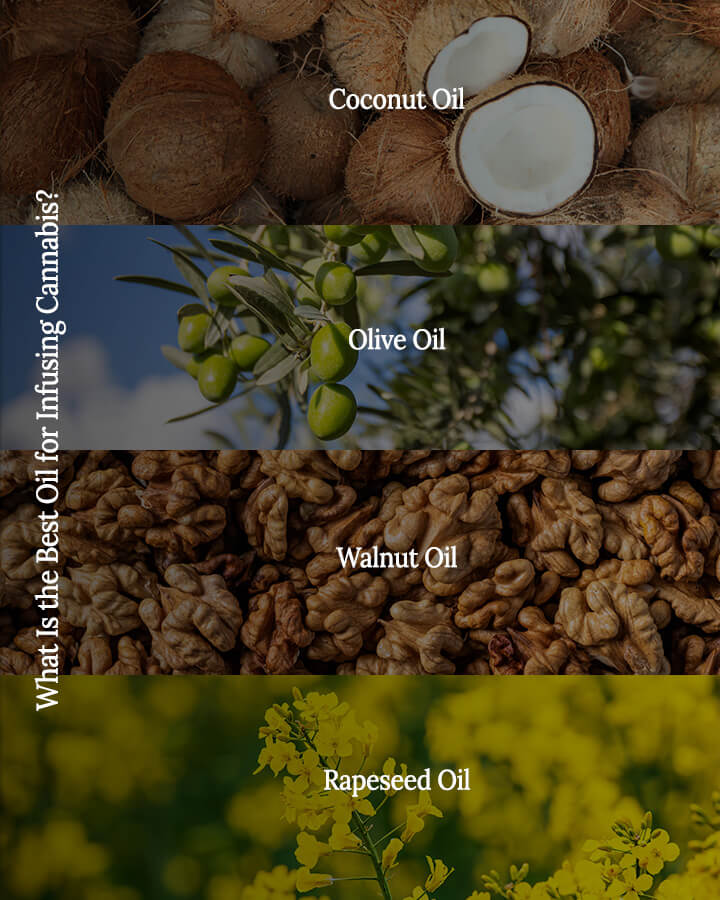
-
Coconut Oil
Coconut oil stands out with its high saturated fat content, which allows for a high degree of cannabinoid absorption, making for a very potent canna-oil. Its flavour is distinct but combines well with a variety of recipes—it has a mild, slightly sweet taste that complements a wide range of edibles, from baked goods to savoury dishes. Plus, the texture of coconut oil is unique; it solidifies at room temperature, providing a creamy consistency that works well in solid edibles and for topical applications.
-
Olive Oil
Olive oil carries a distinct nutty and fruity flavour that makes it a great addition to a variety of dishes, especially Mediterranean ones. With so many different olive oils available, you have a lot of options here to fine-tune the taste. While it may not absorb cannabinoids quite as efficiently as coconut oil, its monounsaturated fat content still ensures a relatively potent infusion—and a healthy one at that. Its liquid state at room temperature and its rich texture make infused olive oil ideal for yummy salad dressings, dips, or for drizzling directly onto a dish (or in your mouth).
-
Walnut Oil
This one is for the gourmets among us—walnut oil has a delicate, nutty flavour, adding a special twist to salads, baked goods (savoury and sweet), and pasta. Although its fat content is lower than that of coconut oil and olive oil, walnut oil still facilitates effective cannabinoid absorption. However, results tend to be slightly less potent than with the above-mentioned options. The oil's light texture and rich flavour profile make it a good choice for those looking to add a more complex touch to their cannabis cuisine. Being a more pricey and less potent option, walnut oil is best suited for those prioritising flavour over maximum potency.
-
Rapeseed Oil
Known for its light flavour and high smoke point, rapeseed oil is a highly versatile, healthy option for cannabis infusions. Its subtle taste allows the cannabis to shine through without much interference. While its fat content is lower than coconut oil's, rapeseed oil still offers a decent level of cannabinoid absorption, resulting in moderately potent infusions. Its texture is similar to that of olive oil, making for a perfect all-rounder cooking oil. For those seeking a neutral flavour and great versatility in the kitchen, rapeseed oil might be the one.
-
Cannabutter vs Canna-Oil
How do you choose between cannabutter and canna-oil? While this can seem like an overwhelming question, there are actually some tangible factors you can consider to make a sensible decision. There’s no one-size-fits-all option, as the optimal choice will always depend on factors like desired potency, flavour preferences, and the intended texture of the final dish.
Cannabutter is loved for its delicious, rich flavour derived from full-fat milk—this is crucial to the creation of iconic, mouth-watering edibles like brownies/space cakes or cookies. The process of making cannabutter involves simmering cannabis flower in butter and water for an extended period, extracting valuable cannabinoids, terpenes, and flavonoids. This method ensures that these compounds can be easily absorbed by the body when consumed.
Canna-oils, on the other hand, are vegan, sometimes healthier alternatives to cannabutter. As each oil has its unique set of advantages (and disadvantages) and its own flavour profile, canna-oil’s compatibility with a dish really depends on the base.
When it comes to potency, studies suggest that fats like clarified butter, coconut oil, and olive oil are best at absorbing THC and other cannabinoids, but this isn’t fully understood yet. If you’re after maximum potency, clarified butter might be the best option as its cannabinoid absorption rate is said to be particularly high.
In terms of flavour, think about how you want to use your infusion. For cookies, for example, the flavour of cannabutter will work much better, while you’d probably rather use olive oil when preparing a dressing for a summery salad. Also consider the texture, as this, while often underestimated, will significantly affect the “mouthfeel” of your final product, making it a determining factor in the compatibility of each oil with various recipes.
Ideal Ratio of Oil to Cannabis
Does weed olive oil get you high? Absolutely—as long as you decarb your cannabis (see below) and use a strain that contains ample amounts of THC. With that in mind, you might want to consider how much herb to add to your oil in the first place.
While the ideal infusion ratio of oil to cannabis can vary depending on your desired potency and how you plan to use the oil, a common starting point is a 1:1 ratio. This will result in quite a potent infusion suitable for anything from cooking to topical applications. However, for those seeking milder effects or those new to cannabis edibles, potency can be moderated by adjusting (lowering) the amount of cannabis—for example, a 2:1 oil to cannabis ratio.
The starting THC or CBD content of the cannabis strain being used will, of course, also influence the strength of the final product, as will the amount of oil you end up consuming in one go.
Ultimately, finding the perfect ratio may require some experimentation. With edibles in particular, it’s best to err on the side of caution, as their effects can be significantly stronger and longer-lasting than with inhaled cannabis smoke or vapor. Start low and work your way up step by step. Also, be mindful of the delayed onset—edibles can take anywhere from 30 minutes to an hour and a half to “hit”.

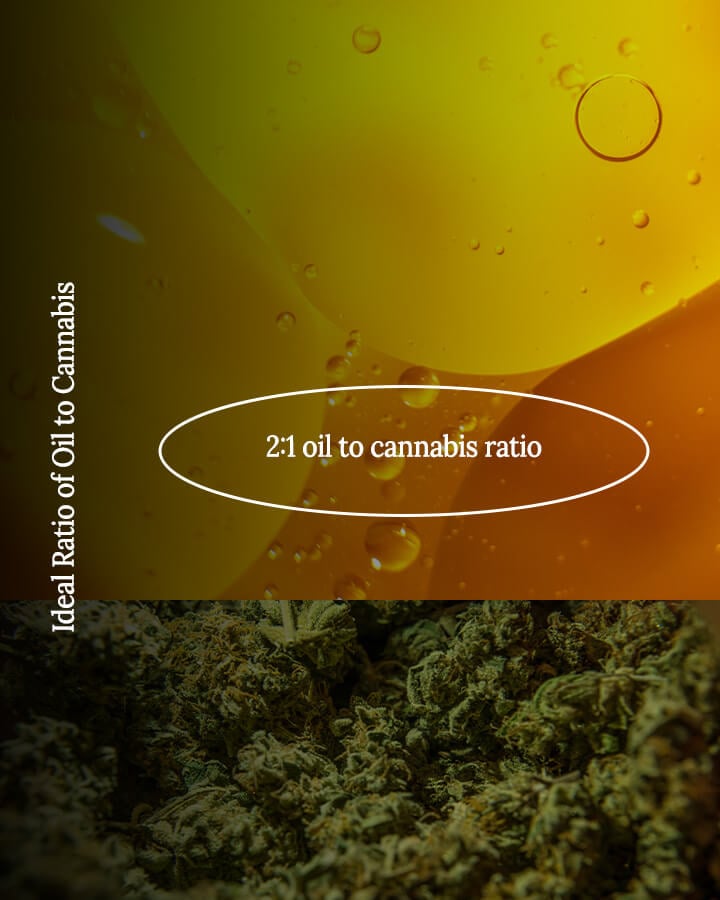
How to Infuse Olive Oil With Cannabis
Now that you’ve acquired a whole load of valuable information about fats and weed, you shall be rewarded with an easy step-by-step guide for making your own cannabis olive oil. Before getting started, you might want to know how long it takes to infuse olive oil with cannabis—well, the process can take a few hours, but we promise it’ll be worth it.
Ingredients
- 7–10g ground cannabis flower
- 240ml olive oil
Equipment
- Baking sheet
- Parchment paper
- Oven
- Mesh strainer or cheesecloth
- Cannabis grinder (optional, but blenders and coffee grinders can over-pulverise the cannabis, leading to a bitter taste)
- Saucepan, stock pot, double-boiler, or slow cooker
- Glass container/jar for storing the infused oil
Directions
- Begin by decarboxylating your cannabis to activate the THC and CBD. Preheat your oven to 110ºC. Then, grind your weed. Avoid grinding it too finely to prevent it from passing through the cheesecloth or strainer later. Then, spread the ground or hand-broken bud evenly on a baking sheet lined with parchment paper.
- Bake for 30–40 minutes. This converts the non-intoxicating THCA in the plant into THC.
- Combine the olive oil and decarboxylated cannabis in a saucepan. Simmer on low heat for 2–3 hours, ensuring the temperature of the oil remains between 71°C and 93ºC. This prevents the THC from being destroyed.
- Place a mesh strainer or cheesecloth over your glass storage container and carefully pour the cannabis oil mixture through. Avoid squeezing the remnants to prevent adding excess chlorophyll, which can impart a more plant-like taste to the oil. Discard the plant material. The cannabis-infused olive oil should last for at least two months, with an extended shelf life if you refrigerate it.
Note: Be careful when using the cannabis-infused olive oil in heated dishes. Avoid microwaving and opt for low heat to preserve the oil's potency and flavour.
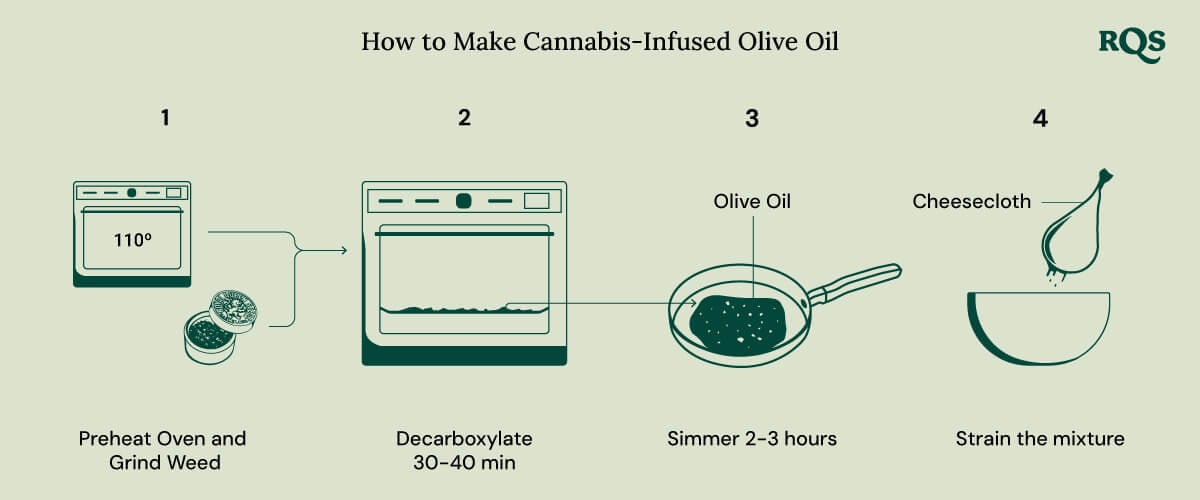
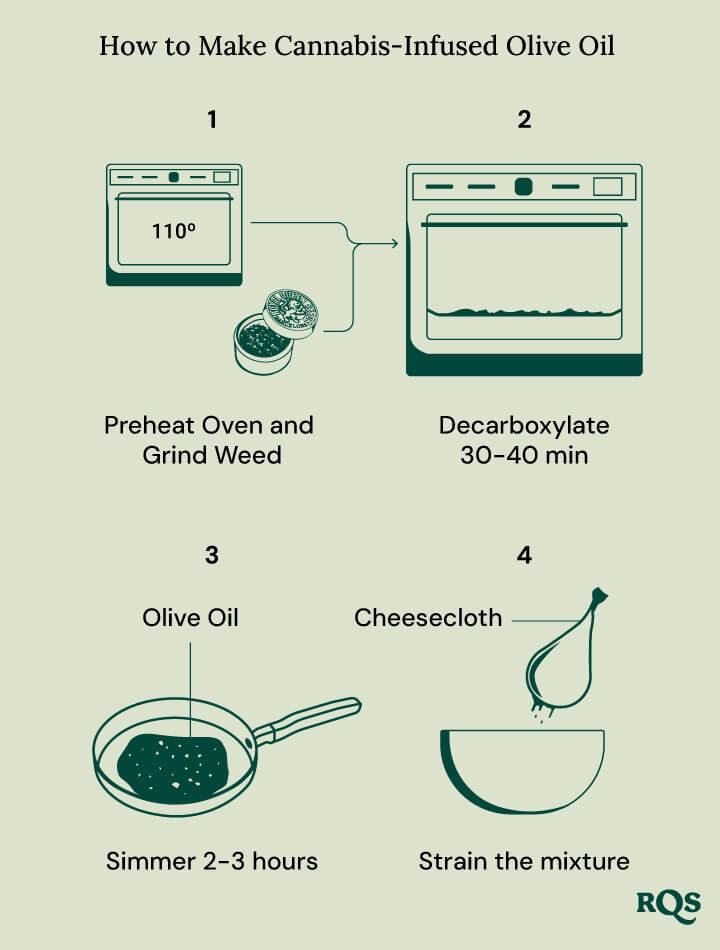
Dosing Cannabis Olive Oil
Determining the correct dose of cannabis-infused olive oil can be challenging due to the varying potency of different cannabis strains and individual tolerance levels. Start with small doses, especially if you're new to edibles, and gradually increase as needed/desired. A common dose to start with is 1 teaspoon of infused oil, which then can be adjusted based on the effects and personal preference. Consult our comprehensive guide on dosing cannabis in its various forms to ensure safe use.
Cannabis Olive Oil: Versatile and Tasty
Cannabis-infused olive oil is not only a fun and potent addition to your culinary repertoire, but also truly delicious. Its versatility allows it to be used in a wide range of dishes, from simple dressings to complex sauces and mind-blowing baked goods. Having read this article, you’re more than ready to master both the production and the application of canna-oil. We wish you great fun with both!
DisclaimerWhen consumed, THC metabolizes into 11-hydroxy-THC, which enters the body through the stomach and liver, resulting in a significantly stronger effect due to its increased affinity for CB1 receptors in the brain.
Ensure accurate portion control. Begin with small doses and gradually increase to develop tolerance.
Remember: Set and Setting will help you deal with various situations.
Stay Cultivated.








































